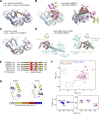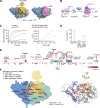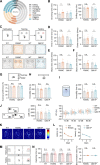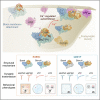Ca2+-induced release of IQSEC2/BRAG1 autoinhibition under physiological and pathological conditions
- PMID: 37787765
- PMCID: PMC10548395
- DOI: 10.1083/jcb.202307117
Ca2+-induced release of IQSEC2/BRAG1 autoinhibition under physiological and pathological conditions
Abstract
IQSEC2 (aka BRAG1) is a guanine nucleotide exchange factor (GEF) highly enriched in synapses. As a top neurodevelopmental disorder risk gene, numerous mutations are identified in Iqsec2 in patients with intellectual disabilities accompanied by other developmental, neurological, and psychiatric symptoms, though with poorly understood underlying molecular mechanisms. The atomic structures of IQSECs, together with biochemical analysis, presented in this study reveal an autoinhibition and Ca2+-dependent allosteric activation mechanism for all IQSECs and rationalize how each identified Iqsec2 mutation can alter the structure and function of the enzyme. Transgenic mice modeling two pathogenic variants of Iqsec2 (R359C and Q801P), with one activating and the other inhibiting the GEF activity of the enzyme, recapitulate distinct clinical phenotypes in patients. Our study demonstrates that different mutations on one gene such as Iqsec2 can have distinct neurological phenotypes and accordingly will require different therapeutic strategies.
© 2023 Bai et al.
Conflict of interest statement
Disclosures: The authors declare no competing interests exist.
Figures











Comment in
-
BRAG about (s)lots.J Cell Biol. 2023 Dec 4;222(12):e202310023. doi: 10.1083/jcb.202310023. Epub 2023 Nov 8. J Cell Biol. 2023. PMID: 37938213 Free PMC article.
References
-
- Accogli, A., Eric Jarvis G., Schiavetto A., Lai L., Amirali E.L., Jimenez Cruz D.A., Rivière J.B., and Trakadis Y.. 2020. Psychiatric features and variable neurodevelopment outcome in four females with IQSEC2 spectrum disorder. J. Genet. 99:47. - PubMed
-
- Adams, P.D., Afonine P.V., Bunkóczi G., Chen V.B., Davis I.W., Echols N., Headd J.J., Hung L.W., Kapral G.J., Grosse-Kunstleve R.W., et al. . 2010. PHENIX: A comprehensive python-based system for macromolecular structure solution. Acta Crystallogr. D Biol. Crystallogr. 66:213–221. 10.1107/S0907444909052925 - DOI - PMC - PubMed
-
- Ansar, M., Chung H.L., Al-Otaibi A., Elagabani M.N., Ravenscroft T.A., Paracha S.A., Scholz R., Abdel Magid T., Sarwar M.T., Shah S.F., et al. . 2019. Bi-allelic variants in IQSEC1 cause intellectual disability, developmental delay, and short stature. Am. J. Hum. Genet. 105:907–920. 10.1016/j.ajhg.2019.09.013 - DOI - PMC - PubMed
Publication types
MeSH terms
Substances
LinkOut - more resources
Full Text Sources
Molecular Biology Databases
Research Materials
Miscellaneous

